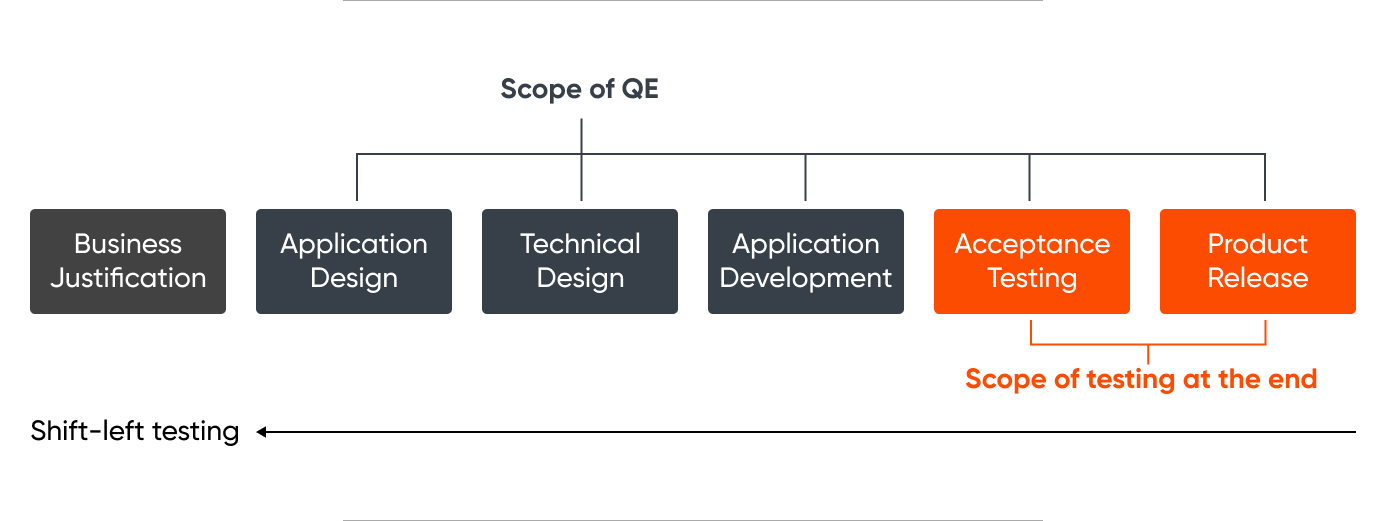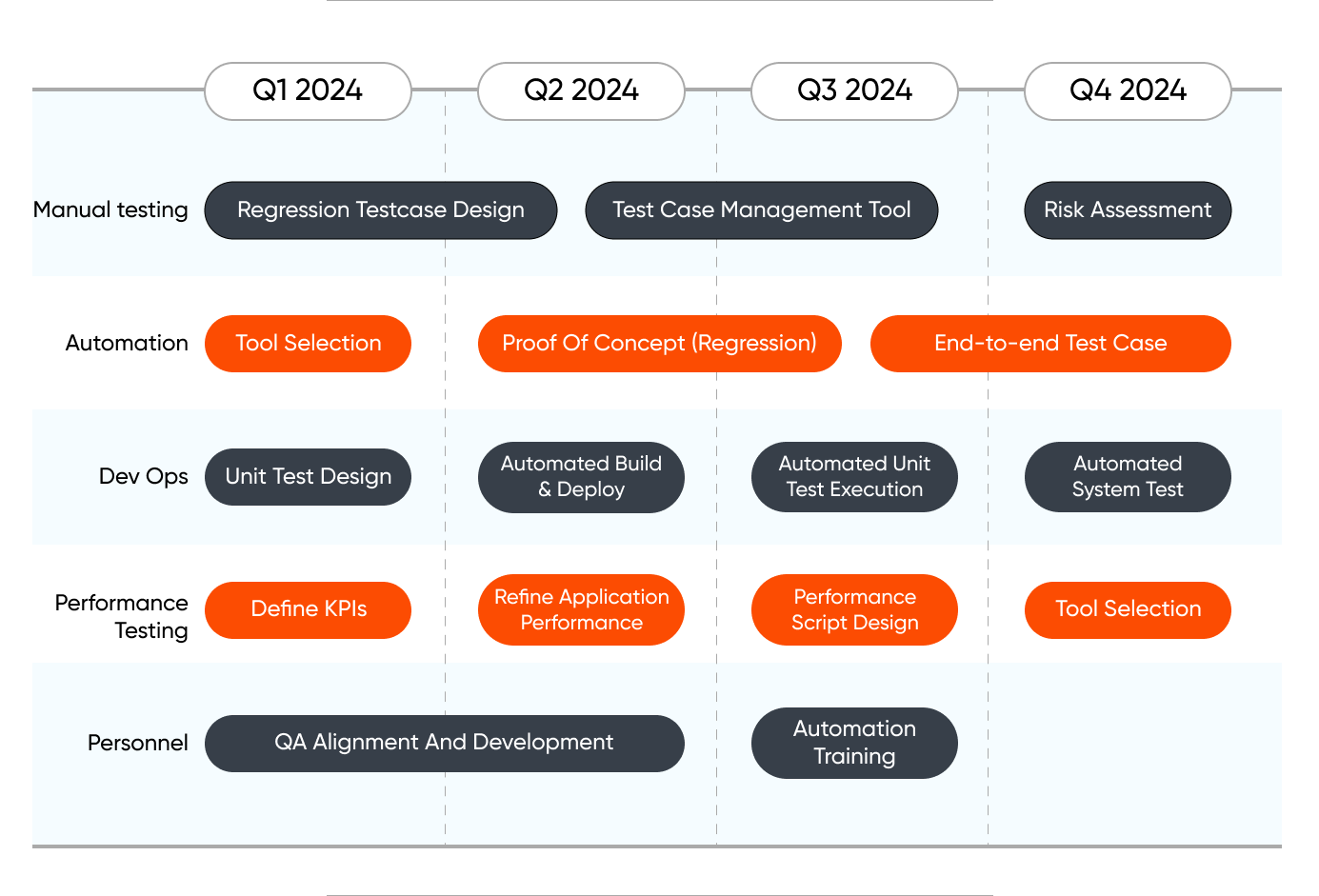Quality is the ultimate differentiator in the software world. But achieving it isn't just about throwing testers at the problem.
There ought to be a strategic approach that turns testing from a reactive chore into a proactive one. To get there, QA maturity is inevitable for any organization.
QA maturity is the efficiency of your testing practices. Assessing your maturity stature pinpoints strengths and weaknesses, sets goals, and devises strategies for testing process enhancement.
Google's journey is a compelling example of QA maturity.
|
In Google's early days, manual testing caused delays in feature releases and bug fixes. Initial attempts at frontend automation helped, but there was a dire need for QA maturity as the company’s products grew in size. Google started its test maturity journey by splitting testers into two roles:
This role change significantly improved testing efficiency and metrics-driven engineering. TEs became experts in automation, supporting product development efforts, and collaborating with SETs. Introducing these new roles and automation enhanced efficiency and enabled early bug detection. To further optimize, SETs expanded their focus beyond testing and building tools to automate code writing, releases, and production monitoring. The expanded role led to the title "Software Engineer, Tools, & Infrastructure (SETI)." Today, SETIs and TEs collaborate to optimize the entire development cycle, emphasizing QA Maturity. |
The Importance of QA Maturity and Transition to QE
Testing, in the end, is the traditional way of dealing with quality. However, this siloed approach often becomes inefficient for the following reasons.
|
The result?
Quality becomes an afterthought, bolted on rather than woven into the entire development process.
In light of these challenges, it's clear that the traditional, isolated approach to testing is not sufficient. The shift from reactive measures to a more integrated, proactive strategy is imperative. This is where the transition to Quality Engineering (QE) becomes vital.
Quality Engineering permeates the entire software lifecycle, encompassing every stage from conception to deployment.
This shift-left philosophy prioritizes early defect detection, preventing costly rework, and ensuring quality is built into the development pipeline.

How To Assess & Improve An Organization's QA Maturity
Optimizing QA begins with a crucial step: assessment!
It involves meticulously evaluating an organization's testing maturity level, encompassing processes, practices, tools, and culture.
The first step is to select a framework that suits your requirements and team size.
Step 1: Choose A Framework
A Test Maturity Framework helps assess and enhance the effectiveness of testing processes in an organization. It gauges the maturity of testing practices, guiding improvement for better software quality assurance.
Here are the most prominent ones:
|
Scope |
Broad and deep, covering all aspects of testing |
Focused on improving efficiency and specific areas |
|
Complexity |
Comprehensive framework, requiring detailed assessment and extensive process changes. |
It is simple and easy to implement due to its clear, structured approach. |
|
Ideal for |
Large organizations with dedicated QA teams |
Smaller teams or those starting their maturity journey |
Once the framework is chosen, the next steps involve gathering relevant data.
Here’s an example of a framework
Step 2: Gather Data
Collect information on various aspects of the organization's testing process, including:
- Processes: How are testing activities planned, executed, and monitored?
- People: What are the testing team's skills, qualifications, and experience?
- Tools & Technology: Which tools are used for test automation, defect management, and other tasks?
- Metrics: Which Key Performance Indicators (KPIs), test coverage metrics, defect density, and other relevant measurements are used to gauge the effectiveness of the testing processes?
- Culture: What is the attitude towards quality, collaboration, and continuous improvement?
Step 2: Benchmarking Against Industry Standards:
This data collection allows organizations to compare their testing maturity against industry standards. Benchmarking provides valuable insights into how the organization is positioned, helping set realistic goals.
Step 3: Create A Tailored Roadmap
A comprehensive improvement roadmap is created, drawing insights from the assessment findings. This plan carefully prioritizes important areas, sets achievable goals, and outlines improvement steps. The roadmap must be customized for the organization's needs and serve as the blueprint for ongoing improvement.

Step 4: Execution of the roadmap
The team puts the roadmap into action. Planned improvements are systematically implemented, addressing identified issues. This phase ensures tangible progress and fosters the team's journey toward achieving higher maturity levels in the testing process.
Step 5: Continuous Improvement
Ongoing monitoring of the testing process ensures a continuous evaluation of its impact on project quality.
Through iterative assessments, adjustments to the improvement plan are made, facilitating gradual progress toward higher maturity levels.
This cultivates a culture of continuous improvement, establishing clear behavioral patterns to manage project challenges effectively.
Best Practices For Attaining QA Maturity
|
What To Expect During Maturity Stages
Embarking on a journey of software quality involves traversing through distinct maturity stages. Each stage brings unique expectations as you progress.
Here they are:
| Quality Control | Quality Assurance | Quality Engineering |
DevOps-Driven QE |
Advanced QE |
|
Comprehensive quality training |
Formal documentation. |
Test cases are designed and prioritized based on defect risk. |
Continuous testing throughout the development lifecycle. |
AI is used to automate testing tasks. |
|
As-needed testing without a formal plan or documentation. |
Well-defined QA roles. |
Tools and frameworks automate testing. |
Automated deployment. |
Optimization of the CI/CD pipeline. |
|
Focus on quick defect resolution with minimal documentation. |
Well-defined processes. . |
Optimized test cases. |
User-focused testing. |
Predictive analytics. |
|
Manual execution of test cases to verify core functionalities. |
Metrics-driven practices. |
Root-cause analysis. |
Full integration of QE into the CI/CD pipeline. |
Full integration of QE into SDLC. |
|
The QC stage sets the foundation for structured QE practices. |
Test-automation focus. |
Early identification and fixing of defects. |
|
Automated test data management. |
A Short Tale: How QA Maturity Helped Zalando Thrive
Zalando faced scalability issues with its monolithic architecture (interconnected and interdependent components), limiting productivity and innovation. As the company expanded, the system's complexities grew, affecting product quality and business growth.
Zalando embarked on a journey of QA maturity, transitioning from a monolith to a distributed microservices architecture.
They adopted the MAMOS framework - Mamos is a Quality Engineering framework that assesses your Quality at Speed capabilities, identifying key assets and areas for improvement, focusing on Methods, Architecture, Management, Organization, and Skills.
In short, Quality Engineering transformed Zalando by building microservices, evolving technology, and enabling business growth. On Black Friday 2019, 840,000 new customers were acquired, and the NPS (Net Promoter Score) soared from -2.90 to 10.81 (Q4 2017 to Q4 2018).
Zalando's commitment to autonomy, agility, and quality at speed allowed them to reinvent their business and continuously thrive in the competitive market.
Are you seeking experts to assess your organization's QA maturity and guide you toward Quality Engineering? Let's schedule a call!

Shweta Sharma, Director of Quality Engineering Services
When Shweta isn't at work, she's either on a family road trip across the country or she's dancing with her kids—it's a great combination.
.png)
Vishnu S Kumar, Marketing Associate
A humble and passionate soul who loves to explore the world on his bike—that’s Vishnu. In his free time, you’ll often find him at cafes, sipping coffee and watching different genres of shows.

 We respect your privacy. Your information is safe.
We respect your privacy. Your information is safe.



Leave us a comment